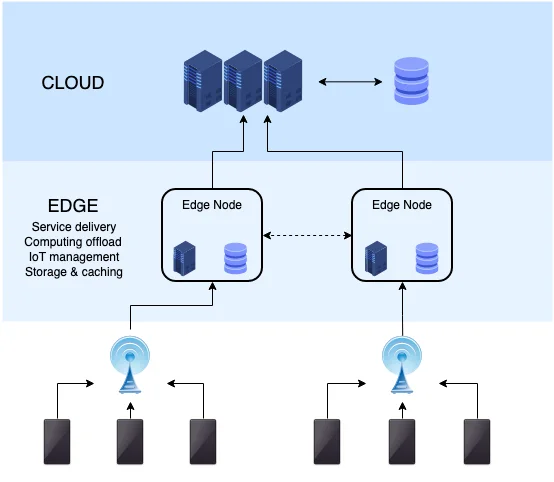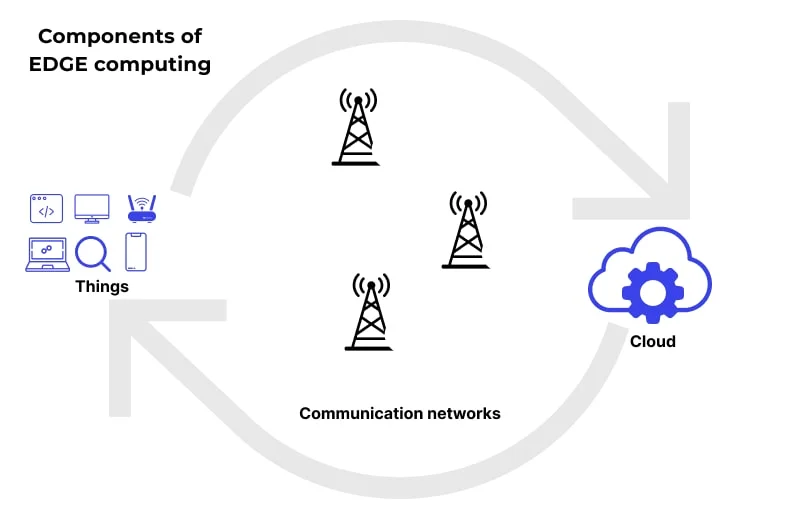Technology has come a long way from clunky early computers to today’s pocket-sized powerhouses. But there’s a new buzzword you should know: Edge Computing. Imagine this – big companies like Netflix used to store all their stuff on the cloud, but that caused slow-downs. Here’s where edge computing steps in.
Instead of keeping things far off in the “cloud,” it brings the action closer to you. This means quicker responses and smoother connections. So, whether you’re binge-watching, listening to music, or doing something high-tech, edge computing is changing the game.
Let’s dive into what edge computing is and why it’s making waves in the tech world.
An Overview of Edge Computing


Edge computing is a distributed computing architecture that differs from the traditional centralized computing model. The edge refers to the physical location of computing resources near or at a network’s endpoints. Edge computing aims to reduce latency and improve performance for both cloud-based applications and IoT devices.
Edge computing can be used to:
- Improve network performance by reducing traffic on the backbone.
- Deliver content directly from local servers instead of sending data to a central location for processing.
- Provide real-time analytics on data collected by IoT devices, such as autonomous vehicles and smart homes.
Parts Of An Edge Network
The edge network is the part of an enterprise network that connects directly to the Internet. It includes the core network and a set of routers, switches, and other devices closer to end users than the core network.


An edge network has the following parts:
- Provider/enterprise Core: This part of the network is responsible for routing traffic between multiple locations within or across organizations. It also provides access to the Internet for each site. The provider/enterprise core is often called the “backbone.”
- End-user premises Edge: This part of an edge network connects end users directly to their providers’ networks. The devices in this part range from simple access points (APs) to complex wireless routers with multiple ports.
- Service Provider Edge: This part sits at the border between an enterprise’s private and the service provider’s public networks. Service providers manage their service provider edges, but enterprises usually have little control over them.
- Device Edge: The devices used by end users, such as laptops, smartphones, and tablets, fall under this category.
Characteristics of Edge Computing
The characteristics of edge computing are:
Proximity
Edge devices are typically located close to their users at the end of a network. This proximity enables local processing and reduces latency. For example, an industrial drone flying over a field must communicate with its operator as quickly as possible to avoid collisions or damage.
Edge computing can enable this communication by processing data close to the drone rather than sending data to the cloud via a long-distance network connection.
Offline Operation
In some cases, connecting an end device directly to the internet is impossible or economically viable. Examples include mobile devices that work without a connection or sensors working in remote locations. In these cases, edge computing can store data locally on the device until it can be transmitted via Wi-Fi or cellular network when an opportunity arises.
Local Processing
Edge computing also allows local data processing before it returns to the cloud for storage or analysis. This means that devices can make decisions without waiting for instructions from a central server, which increases their responsiveness and reduces latency when interacting with other devices in the IoT ecosystem.
Privacy Enhancement
Edge Computing can protect user privacy by storing sensitive data at the network’s edge. The data is encrypted before being transmitted over the network, and once it reaches the edge device, it can be decrypted locally on the device before being processed. This ensures that only authorized users have access to sensitive information.
Scalability
Edge computing provides better scalability than traditional cloud-based systems because it allows services to be distributed across multiple devices. This means they can simultaneously handle more requests and provide greater flexibility as demand changes. As more people connect to the internet, there will be an increasing need for this type of technology.
Real-time Insights
With the proliferation of IoT devices, there’s an ever-growing amount of data being generated by connected devices. That makes it difficult for organizations to understand what’s happening with their assets in real-time.
With edge computing, companies can easily collect and analyze data from machines at the source to make better decisions faster and respond more quickly to issues as they arise.
Reduced Bandwidth Usage
Edge computing reduces the amount of data that needs to be transferred over a network by processing data near where it is generated. This can reduce bandwidth usage, particularly when transmitting large amounts of data.
Resilience
In an edge computing environment, if one component fails, others can take over its functions. For example, if a server fails, the cloud automatically assigns new tasks to other servers without disrupting service.
This improves resilience in your system and ensures that your application continues operating even when there are problems in the network or with individual servers.
Diverse Applications
Edge computing supports diverse applications and scenarios. For example, it can be used for security cameras, industrial equipment monitoring, or managing city traffic congestion.
Three Principal Network Limitations of Edge Computing
With the rise of IoT, there is a need for more powerful processing capabilities at the edge of the network, where data comes from. This trend is driven by three main limitations of today’s IT environment:
- Bandwidth: The bandwidth requirement for edge computing is much higher than for cloud computing. This can be addressed by using a high-speed network with multiple paths.
- Latency: Latency is another challenge for edge computing, where data must travel long distances to get processed. This can be overcome by using a high-speed network with multiple paths.
- Congestion/Reliability: To overcome congestion and reliability issues, edge devices must be able to switch between different networks and perform self-healing activities when needed.
Edge Computing vs Cloud Computing: What’s the Difference?
Cloud and edge computing are very different methods for distributing software and data. They each have their benefits and drawbacks, making it difficult to choose between them.
| Edge Computing | Cloud Computing |
| Processing happens closer to the data source or user | Processing occurs in remote data centers |
| Low latency, quick responses due to proximity | Higher latency due to geographical distance |
| Suited for real-time applications and IoT devices | Commonly used for web applications and data storage |
| Works well with limited or intermittent connectivity | Requires stable and reliable internet connection |
| Better for privacy as data often remains on local devices | Raises potential privacy concerns due to remote data storage |
| Scalability is limited by local resources | Highly scalable through server farms and virtualization |
| Ideal for scenarios requiring offline capabilities | Online access is usually required for operation |
Use Cases of Edge Computing
The absence of a universally accepted definition for Edge processing has led us to categorize its use cases into three distinct scenarios:
- Remote ‘Lights Out’ Edge Server Farms: These can range from small hardware racks in remote locations to large server farms. This unique and diverse Edge environment demands new organizational models, advanced software architectures, and high adaptability to manage a mix of equipment while minimizing hands-on control efficiently. Scalability and management of different types of equipment are crucial aspects here.
- Containerized IT Edges: This scenario involves consolidated systems residing together. It encompasses a stack that includes servers, operating systems, storage, networking, and enhanced power and cooling solutions to support all components. Containers are highly standardized, yet they can be customized to meet specific Edge requirements by adding extra features.
- Internet of Things (IoT): Competent processors enable real-time analysis for applications requiring immediate decisions. IoT endpoints are becoming more intelligent, gaining the ability to operate autonomously and make decisions without constant communication with a central platform. This evolution empowers applications that demand rapid responses and continuous analysis.
Challenges of Edge Computing
The benefits of edge computing are undeniable. However, there are some challenges to overcome.
Connectivity
The first challenge is connectivity. Edge devices may be in remote locations and may not have access to the same level of connectivity as the cloud or even other cloud-based services. This means some applications will run slower if they depend on real-time communication between devices and the cloud.
Limited Capability
Another challenge is that local processing power is limited compared to a centralized system such as the cloud or data center. This limits what can be done with each device and makes it challenging to develop sophisticated applications requiring heavy computation and storage capabilities at the edge.
Data Lifecycles
Data lifecycles refer to when data is stored and how long it should be kept for reporting purposes before being deleted or archived for future use.
The challenge here is ensuring that data is stored locally until it needs to be sent back to the cloud for analysis and then deleted from local storage once it has been analyzed by an application running on a centralized system like the cloud or data center.
Security
Because edge computing uses low-power devices to process data, there are increased security risks involved with using such devices compared to traditional on-premises systems. A single point of failure in an edge system could harm your entire organization’s operations.
Elevating Edge Computing with Taikun: Empowering Seamless Integration
As the digital landscape continues to reshape, edge computing remains a linchpin innovation, fundamentally altering data processing and connectivity norms. Its applications span diverse domains, from IoT devices making lightning-fast decisions to containerized solutions and remote server farms tackling the complexities of decentralized data processing.
Within the dynamic landscape of edge computing, Taikun stands as a beacon of innovation. Our fundamental mission is to empower businesses by seamlessly integrating automated tools for edge computing, providing a comprehensive suite of services. You can self-start with Taikun today for free or jump on a call with one of our consultants to see a live demo customized to your needs.


